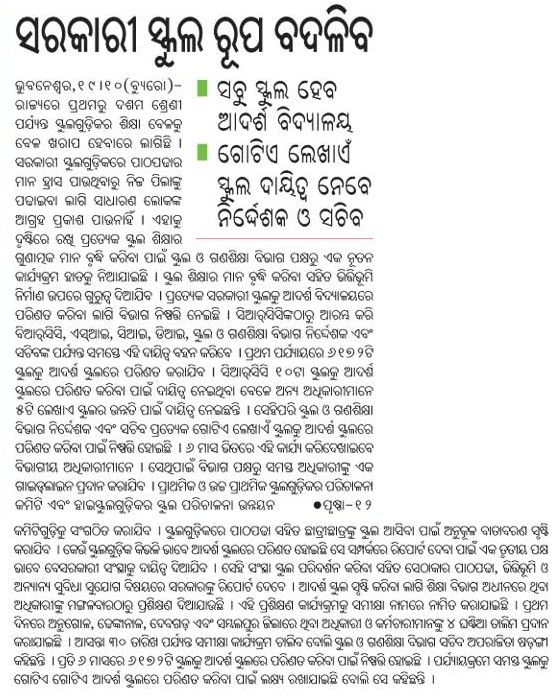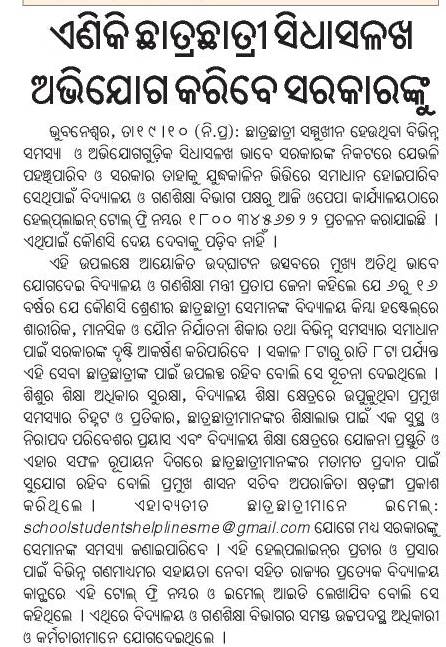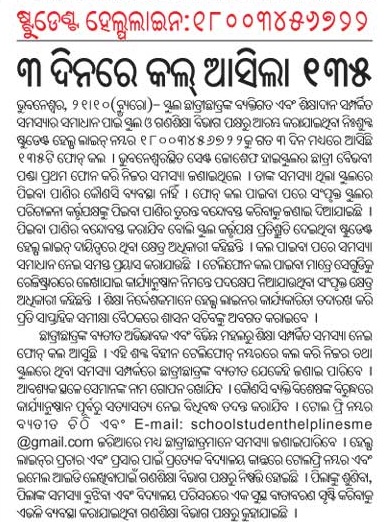Some notable K-12 Schools in Bhubaneswar – from a Dharitri supplement
1 comment January 31st, 2012
From Dharitri:

From Samaja:

From Dharitri:

October 22nd, 2010
For additional background and the list of 123 EBBs in Odisha see https://www.orissalinks.com/archives/1689. Following is from the PIB http://pib.nic.in/release/release.asp?relid=60782.
The Cabinet Committee on Economic Affairs today approved the setting up of 1000 additional model schools as a benchmark of excellence in Educationally Backward Blocks (EBBs) through State Governments, thereby taking the total number of model schools to be set up through the State Governments to 3500.
The financial requirement for setting up 2500 schools under State Governments, which were approved by CCEA in November 2008, was estimated as Rs.9322 crore during the 11th Five Year Plan, of which the central share is Rs.7457 crore. Requirement for additional 1000 schools (current proposal) has been estimated to be Rs.3304 crore with the Central share of Rs.2478 crore. Thus the estimated Central share for establishing 3500 schools in the Government sector is Rs.9935 crore during the 11th Five Year Plan.
Each school will have 560 students, the total beneficiary for 3500 schools therefore being 19.60 lakh students. The programme will be implemented through the societies set up by the State Governments for this purpose.
The present proposal is meant for 3500 EBBs in 27 States/UTs, although the model school scheme will cover 6000 blocks in all States/UTs.
The salient features of the Scheme are as follows:
(i) Every EBB will be eligible for one model school under State Governments.
(ii) These schools to have classes from VI to XII or from IX to XII.
(iii) These schools to have norms and standards equal to or better than Kendriya Vidyalayas
(iv) Medium of instruction and affiliating board will be decided by the State Governments.
(v) 75% of the recurring and non-recurring cost, subject to scheme norms, will be borne by the Central Government except for special category states, for which the sharing pattern is 90:10.
The major impact of the scheme will be to open up access to quality secondary education to talented rural students. The scheme is expected to provide a major fillip to availability of good quality schools in rural areas, thereby nurturing talent in such areas. These schools are expected to act as pace-setting institutions and to have a demonstration effect on neighbouring schools.
April 24th, 2010
Following is from http://pib.nic.in/release/release.asp?relid=44613.
| IN THE FIRST PHASE 2,500 MODEL SCHOOLS TO BE SET UP IN EDUCATIONALLY BACKWARD BLOCKS
|
|
| 16:35 IST | |
|
The Cabinet Committee on Economic Affairs today gave its approval to the setting up of 6,000 Model Schools at the Block level in the country. Initially, in the First Phase of the implementation of this Centrally Sponsored Scheme, 2,500 Model Schools will be set up in the Educationally Backward Blocks (EBBs). These schools will be set up through State Governments. A model school will have infrastructure and facilities, at least of the standard as in a Kendriya Vidyalaya and with stipulations on pupil-teacher ratio, ICT usage, holistic educational environment, appropriate curriculum and emphasis on output and outcome. Objective: The main objectives of the scheme are, ¨ To have at least one good quality secondary school in every block. ¨ To have a pace setting role for these schools. ¨ To try out innovative curriculum and pedagogy ¨ To be a model in infrastructure, curriculum, evaluation and school governance The salient features of Scheme are as under:
There will a continuous evaluation of the working of the schools by State Government agencies through a regular and well structured system of field visits. Besides, an independent agency may be assigned the task of monitoring of the scheme, including progress of construction for each State. Financial requirement for setting up 2,500 schools during the 11th Five Year Plan has been estimated as Rs.9,321 crore, of which estimated central share is Rs.7,457 crore. Planning Commission has allocated Rs. 12,750 crore for this scheme under the 11th Five Year Plan. Rs. 650 crore has been provided in the budget for 2008-09. Sharing pattern will be at the ratio of 75:25 between centre and the states during the 11th Five Year Plan and 50:50 during the 12th Five Year Plan, while for special category states, the sharing pattern would be in the ratio of 90:10. The scheme will be implemented from the current financial year. The Scheme is, however, not to be implemented in the 6 states where assembly elections are being held, till the poll process is over. ————– KKP/sa |
The 123 educationally backward blocks in Orissa are (See also http://education.nic.in/mdm/EEBs.pdf for a bigger list):
| Sl.No. | Name of State/District | Sl.No. | Name EEB Blocks | |
| XI. | ORISSA | |||
| 1 | Sambalpur | |||
| 1 | Dhankauda | |||
| 2 | Rengali | |||
| 3 | Lakhanpur | |||
| 4 | Kolabira | |||
| 5 | Laikera | |||
| 6 | Kirimira | |||
| 7 | Rajborasambar | |||
| 8 | Paikmal | |||
| 9 | Jharbandha | |||
| 10 | Gaisilet | |||
| 11 | ||||
| 12 | Kochinda | |||
| 13 | Jamankira | |||
| 14 | Reamal | |||
| 15 | Barkot | |||
| 16 | Tileibani | |||
| 17 | Naktideul | |||
| 2 | Sundargarh | |||
| 1 | Bisra | |||
| 2 | Lathikata | |||
| 3 | Koida | |||
| 4 | Gurundia | |||
| 3 | Kendujhar | |||
| 1 | Kendujhargarh | |||
| 2 | Harichadanpur | |||
| 3 | Patana | |||
| 4 | Ghatgaon | |||
| 5 | Saharapada | |||
| 6 | Telkoi | |||
| 7 | Champua | |||
| 8 | Jhumpura | |||
| 9 | Joda | |||
| 4 | Mayurbhanj | |||
| 1 | Koliana | |||
| 2 | Sulia Pada | |||
| 3 | Muruda | |||
| 4 | Saras Kana | |||
| 5 | Rairang Pur | |||
| 6 | Bija Tola | |||
| 7 | Bisoi | |||
| 8 | Jamda | |||
| 9 | Bahalda | |||
| 10 | Tiringi | |||
| 11 | Kusumi | |||
| 12 | Gopa Bandhu Nagar | |||
| 13 | Karanjia | |||
| 14 | Jashi Pur | |||
| 15 | Aukruli | |||
| 16 | Raruan | |||
| 5 | Dhenkanal | |||
| 1 | Kankada had | |||
| 2 | Anugul | |||
| 3 | Chhendipada | |||
| 4 | Athmallik | |||
| 5 | Palalahada | |||
| 6 | Forest Area | |||
| 6 | Phulabani | |||
| 1 | Phulabani | |||
| 2 | Phiringia | |||
| 3 | Khajuripada | |||
| 4 | Baudh Sadar | |||
| 5 | Harbhanga | |||
| 6 | Kantamal | |||
| 7 | Baliguda | |||
| 8 | Chakpad | |||
| 9 | Daringbadi | |||
| 10 | G. Udayagiri | |||
| 11 | Nuagaon | |||
| 12 | Raikia | |||
| 13 | Tikabali | |||
| 7 | Balangir | |||
| 1 | Patnagarh | |||
| 2 | Belpara | |||
| 3 | Khaprakhol | |||
| 4 | Titlagarh | |||
| 5 | Muribahal | |||
| 6 | Saintala | |||
| 7 | Bangomunda | |||
| 8 | Turekela | |||
| 9 | Balangir | |||
| 10 | Loisinga | |||
| 11 | Puintala | |||
| 12 | Agalpur | |||
| 13 | Deogaon | |||
| 14 | Tentulikhunti | |||
| 15 | Tarbha | |||
| 16 | Sonepur | |||
| 17 | Dunguripali | |||
| 18 | Binika | |||
| 19 | Biramaharajpur | |||
| 20 | Ulunda | |||
| 8 | Kalahandi | |||
| 1 | Bhawanipatna | |||
| 2 | Kesinga | |||
| 3 | Narala | |||
| 4 | Madanpur Rampur | |||
| 5 | Karlamunda | |||
| 6 | Dharamagarh | |||
| 7 | Junagarh | |||
| 8 | Jayapatna | |||
| 9 | Kokasara | |||
| 10 | Kalampur | |||
| 11 | Golamunda | |||
| 12 | Komana | |||
| 13 | Khariar | |||
| 14 | Sinapali | |||
| 15 | Boden | |||
| 9 | Koraput | |||
| 1 | Padmapur | |||
| 2 | Chandahandi | |||
| 10 | Ganjam | |||
| 1 | Chhatrapur | |||
| 2 | Ganjam | |||
| 3 | Khalikote | |||
| 4 | Kodala | |||
| 5 | Purusottampur | |||
| 6 | Hinjilicut | |||
| 7 | Polasara | |||
| 8 | Kavisurjanagar | |||
| 9 | Rangilunda | |||
| 10 | Kukudakhandi | |||
| 11 | Digapahandi | |||
| 12 | Sanakhemundi | |||
| 13 | Chikiti | |||
| 14 | Patrapur | |||
| 15 | Bhanjanagar | |||
| 16 | Jaganathprasad | |||
| 17 | Buguda | |||
| 18 | Sargad | |||
| 19 | Dharakote | |||
| 20 | Surada | |||
| 21 | R. Udaygiri | |||
| 11 | Puri | |||
| 1 | Dasapalla | |||
November 7th, 2008
Following is from a report in Hindustan Times.
The proposed 6,000 model schools, announced by Prime Minister Manmohan Singh during his Independence Day speech last year, will have better infrastructure and teachers’ strength than the Kendriya Vidyalayas (KVs).
The blueprint prepared by the Human Resource Development Ministry for these schools, which will come up at each block headquarters in the country, says that there will be one teacher for 25 students in these institutions while the ratio in KVs is one teacher to 40 students.
“Not only teacher strength, these institutions will get all advanced facilities, including ICT equipment, facilities for sports, games, music and art and laboratory for mathematics, science and languages,” sources said.
These schools will give equal importance to curricular and extra-curricular activities, including games, music, dance and art. Of the 6,000 schools, 2,500 will be set up on public- private partnership basis while the rest would be established by the government.
The government will provide some grants for these 2,500 schools, while private companies will make contributions. The government is in the process of finalising the modalities for setting up of these schools on PPP mode.
For the rest of the 3,500 schools, the Centre will bear 75 per cent of the establishment cost and state government will provide 25 per cent of the cost. The establishment cost for a school is about Rs 3 crore.
The process of setting up these institutions will start this year while the admission will start from the next session.
September 11th, 2008
| M | T | W | T | F | S | S |
|---|---|---|---|---|---|---|
| 1 | 2 | 3 | 4 | 5 | 6 | |
| 7 | 8 | 9 | 10 | 11 | 12 | 13 |
| 14 | 15 | 16 | 17 | 18 | 19 | 20 |
| 21 | 22 | 23 | 24 | 25 | 26 | 27 |
| 28 | 29 | 30 | ||||